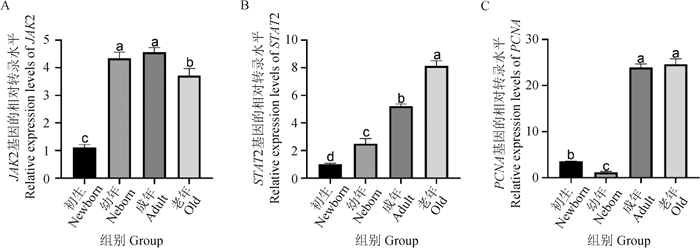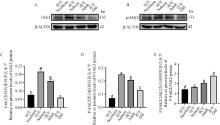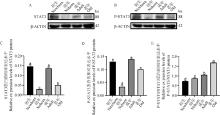





Acta Veterinaria et Zootechnica Sinica ›› 2025, Vol. 56 ›› Issue (6): 2957-2967.doi: 10.11843/j.issn.0366-6964.2025.06.038
• Basic Veterinary Medicine • Previous Articles Next Articles
NIU Yueyue1( ), CUI Yan1,2,*(
), CUI Yan1,2,*( ), YU Sijiu1,2,*, HE Junfeng1, YANG Shanshan1, QI Zhengman1, DOU Wanwan1, CHEN Chunyan1, DENG Yanjiang1
), YU Sijiu1,2,*, HE Junfeng1, YANG Shanshan1, QI Zhengman1, DOU Wanwan1, CHEN Chunyan1, DENG Yanjiang1
Received:2024-08-12
Online:2025-06-23
Published:2025-06-25
Contact:
CUI Yan, YU Sijiu
E-mail:3595167384@qq.com;cuiyan369@sina.com
CLC Number:
NIU Yueyue, CUI Yan, YU Sijiu, HE Junfeng, YANG Shanshan, QI Zhengman, DOU Wanwan, CHEN Chunyan, DENG Yanjiang. Analysis of JAK2, STAT3, P-JAK2/STAT3 and PCNA Proteins Expression in the Lungs of Yaks of Different Ages[J]. Acta Veterinaria et Zootechnica Sinica, 2025, 56(6): 2957-2967.
Table 1
Primer sequences of target gene and housekeeping gene"
| 基因名称Gene name | 引物序列(5′→3′) Primer sequences | 退火温度/℃ Tm | 产物大小/bp Product size | GenBank登录号 GenBank accession number |
| JAK2 | F: TATGGAGTATGTGTCTGTGGAGAGGAG R: TTCCTGTCTTCCTGTCTTCTTCTCTGA | 61.0 | 235 | XM_024996127.2 |
| STAT3 | F: GAGAAGGACATCAGCGGCAAGAC R: GATAGACCAGTGGAGACACCAGGAT | 60.0 | 145 | NM_001012671.2 |
| PCNA | F: CTCGTCTCATGTCTCCTTGGT R: TGTCTTCATTGCCAGCACATT | 56.4 | 134 | XM_005906528.2 |
| β-actin | F: CCGTGACATCAAGGACAAG R: AGGAAGGAAGGATGGAAG | 60.0 | 174 | NM_173979.3 |

Fig. 1
PCR amplification of JAK2, STAT3, PCNA and β-actin A. Amplification results of JAK2; B. Amplification results of STAT3; C. Amplification results of PCNA; D. Amplification results of β-actin. M. DL2000 DNA marker; 1. Lungs of newborn yak; 2. Lungs of juvenile yak; 3. Lungs of adult yak; 4. Lungs of old yak"


Fig. 5
Expression levels of JAK2, STAT3 and PCNA genes in lungs of yaks of different ages A. Expression of JAK2 mRNA level in the lungs of yaks of different ages; B. Expression of STAT3 mRNA level in the lungs of yaks of different ages; C. Expression of PCNA mRNA level in the lungs of yaks of different ages. Different lowercase means significant difference (P < 0.05), the sameas below"


Fig. 6
Expression analysis of JAK2, P-JAK2 proteins and P-JAK2/JAK2 ratio in lungs of yaks of different ages A. Western blot results of JAK2 protein; B. Western blot results of JAK2 protein; C. Expression of JAK2 protein in the lungs of yaks of different ages; D. Expression of P-JAK2 protein in the lungs of yaks of different ages; E. Expression of JAK2 protein in the lungs of yaks of different ages"


Fig. 7
Expression analysis of STAT3, P-STAT3 proteins and P-STAT3/STAT3 ratio in lungs of yaks of different ages A. Western blot results of STAT3 protein; B. Western blot results of P-STAT3 protein; C. Expression of STAT3 protein in the lungs of yaks of different ages; D. Expression of P-STAT3 protein in the lungs of yaks of different ages; E. Expression of P-STAT3/STAT3 protein in the lungs of yaks of different ages"

| 1 |
WANG B , HE J , CUI Y , et al. The HIF-1α/EGF/EGFR signaling pathway facilitates the proliferation of yak alveolar type Ⅱ epithelial cells in hypoxic conditions[J]. Int J Mol Sci, 2024, 25 (3): 1442.
doi: 10.3390/ijms25031442 |
| 2 | 张慧珠. 基于多组学分析牦牛肺动脉平滑肌细胞低氧适应性机制的研究[D]. 兰州: 甘肃农业大学, 2021. |
| ZHANG H Z. Hypoxic adaptability of yak pulmonary artery smooth muscle cells based on multi-omics analysis[D]. Lanzhou: Gansu Agricultural University, 2021. (in Chinese) | |
| 3 | QI X , ZHANG Q , HE Y , et al. The transcriptomic landscape of yaks reveals molecular pathways for high altitude adaptation[J]. Genome Biol Evol, 2019, 11 (1): 72- 85. |
| 4 |
何俊峰, 余四九, 崔燕. 不同年龄高原牦牛肺脏的组织结构特征[J]. 畜牧兽医学报, 2009, 40 (5): 748- 755.
doi: 10.3321/j.issn:0366-6964.2009.05.023 |
|
HE J F , YU S J , CUI Y . Characteristics of lung structure in different age plateau yak[J]. Acta Veterinaria Et Zootechnica Sinica, 2009, 40 (5): 748- 755.
doi: 10.3321/j.issn:0366-6964.2009.05.023 |
|
| 5 |
ZHANG N , DONG M , LUO Y , et al. Danshensu prevents hypoxic pulmonary hypertension in rats by inhibiting the proliferation of pulmonary artery smooth muscle cells via TGF-beta-smad3-associated pathway[J]. Eur J Pharmacol, 2018, 820, 1- 7.
doi: 10.1016/j.ejphar.2017.12.010 |
| 6 |
WEI Z X , CAI X X , FEI Y D , et al. Ntsr1 contributes to pulmonary hypertension by enhancing endoplasmic reticulum stress via JAK2-STAT3-Thbs1 signaling[J]. Transl Res, 2024, 269, 64- 75.
doi: 10.1016/j.trsl.2024.02.002 |
| 7 |
HASSOUN P M . Pulmonary Arterial Hypertension[J]. N Engl J Med, 2021, 385 (25): 2361- 2376.
doi: 10.1056/NEJMra2000348 |
| 8 |
WANG S C . PCNA: a silent housekeeper or a potential therapeutic target?[J]. Trends Pharmacol Sci, 2014, 35 (4): 178- 186.
doi: 10.1016/j.tips.2014.02.004 |
| 9 |
STRZALKA W , ZIEMIENOWICZ A . Proliferating cell nuclear antigen (PCNA): a key factor in DNA replication and cell cycle regulation[J]. Ann Bot, 2011, 107 (7): 1127- 1140.
doi: 10.1093/aob/mcq243 |
| 10 | KONG X , LIU Z , LONG C , et al. Repression of Mafb promotes foreskin fibroblast proliferation through upregulation of CDK2, cyclin E and PCNA[J]. Andrologia, 2022, 54 (6): e14411. |
| 11 |
WANG G S , QIAN G S , ZHOU D S , et al. JAK-STAT signaling pathway in pulmonary arterial smooth muscle cells is activated by hypoxia[J]. Cell Biol Int, 2005, 29 (7): 598- 603.
doi: 10.1016/j.cellbi.2005.03.014 |
| 12 |
BAI L , YU Z , QIAN G , et al. SOCS3 was induced by hypoxia and suppressed STAT3 phosphorylation in pulmonary arterial smooth muscle cells[J]. Respir Physiol Neurobil, 2006, 152 (1): 83- 91.
doi: 10.1016/j.resp.2005.07.001 |
| 13 |
SUN L , LIU L , LIANG D , et al. SOCS5, targeted by miR-155-5p, plays a negative regulatory role in pulmonary hypertension through inhibiting JAK2/STAT3 signaling pathway[J]. BMC Pulm Med, 2024, 24 (1): 52.
doi: 10.1186/s12890-024-02857-6 |
| 14 |
PATEL V B , ZHONG J C , FAN D , et al. Angiotensin-converting enzyme 2 is a critical determinant of angiotensin Ⅱ-induced loss of vascular smooth muscle cells and adverse vascular remodeling[J]. Hypertension, 2014, 64 (1): 157- 164.
doi: 10.1161/HYPERTENSIONAHA.114.03388 |
| 15 |
LI M D , WANG C , LIU J Y , et al. Low concentration arsenite activated JAK2/STAT3 signal and increased proliferative factor expressions in SV-HUC-1cells after short and long time treatment[J]. Environ Toxicol, 2017, 32 (9): 2154- 2162.
doi: 10.1002/tox.22428 |
| 16 | 张凌云, 高宝安. 肺动脉平滑肌细胞与低氧性肺血管重塑形成机制[J]. 中国动脉硬化杂志, 2013, 21 (2): 177- 181. |
| ZHANG L Y , GAO B A . Relationship between pulmonary artery smooth muscle cells and mechanism of hypoxia induced pulmonary vascular remodeling[J]. Chinese Journal of Arterieosclerosis, 2013, 21 (2): 177- 181. | |
| 17 |
ZHANG L , ZHANG Y , ZHOU J , et al. Combined transcriptome and proteome analysis of yak PASMCs under hypoxic and normoxic conditions[J]. Peer J, 2022, 10, 14369.
doi: 10.7717/peerj.14369 |
| 18 |
ZHANG L , WANG Y , WU G , et al. Blockade of JAK2 protects mice against hypoxia-induced pulmonary arterial hypertension by repressing pulmonary arterial smooth muscle cell proliferation[J]. Cell Prolif, 2020, 53 (2): 12742.
doi: 10.1111/cpr.12742 |
| 19 |
TANG H X , QIN X P , LI J . Role of the signal transducer and activator of transcription 3 protein in the proliferation of vascular smooth muscle cells[J]. Vascular, 2020, 28 (6): 821- 828.
doi: 10.1177/1708538120929504 |
| 20 |
XIAO X H , LUO F M , WANG E L , et al. Magnolol alleviates hypoxia-induced pulmonary vascular remodeling through inhibition of phenotypic transformation in pulmonary arterial smooth muscle cells[J]. Biomed Pharmacother, 2022, 150, 113060.
doi: 10.1016/j.biopha.2022.113060 |
| 21 |
HAN B , AN Z , GONG T , et al. LCN2 promotes proliferation and glycolysis by activating the JAK2/STAT3 signaling pathway in hepatocellular carcinoma[J]. Appl Biochem Biotechnol, 2024, 196 (2): 717- 728.
doi: 10.1007/s12010-023-04520-y |
| 22 | ZHANG X , FENG H , DU J , et al. Aspirin promotes apoptosis and inhibits proliferation by blocking G0/G1 into S phase in rheumatoid arthritis fibroblast-like synoviocytes via downregulation of JAK/STAT3 and NF-kappaB signaling pathway[J]. Int J Mol Med, 2018, 42 (6): 3135- 3148. |
| 23 |
HUANG Q , LIU X , YU J , et al. Schisandrin inhibits VSMCs proliferation and migration by arresting cell cycle and targeting JAK2 to regulating the JAK2/STAT3 pathway[J]. Tissue Cell, 2024, 89, 102440.
doi: 10.1016/j.tice.2024.102440 |
| 24 |
陈秋生, 冯霞, 姜生成. 牦牛肺脏高原适应性的结构研究[J]. 中国农业科学, 2006, 39 (10): 2107- 2113.
doi: 10.3321/j.issn:0578-1752.2006.10.024 |
|
CHEN Q S , FENG X , JIANG S C . Structural study on plateau adaptability of yak lung[J]. Scientia Agricultura Sinica, 2006, 39 (10): 2107- 2113.
doi: 10.3321/j.issn:0578-1752.2006.10.024 |
|
| 25 |
SHIBATA R , KAI H , SEKI Y , et al. Inhibition of STAT3 prevents neointima formation by inhibiting proliferation and promoting apoptosis of neointimal smooth muscle cells[J]. Hum Gene Ther, 2003, 14 (7): 601- 610.
doi: 10.1089/104303403321618128 |
| 26 |
YAHATA Y , SHIRAKATA Y , TOKUMARU S , et al. Nuclear translocation of phosphorylated STAT3 is essential for vascular endothelial growth factor-induced human dermal microvascular endothelial cell migration and tube formation[J]. J Biol Chem, 2003, 278 (41): 40026- 40031.
doi: 10.1074/jbc.M301866200 |
| 27 |
ROGER I , MILARA J , MONTERO P , et al. The role of JAK/STAT molecular pathway in vascular remodeling associated with pulmonary hypertension[J]. Int J Mol Sci, 2021, 22 (9): 4980.
doi: 10.3390/ijms22094980 |
| 28 |
HAN D , GONG H , WEI Y , et al. Hesperidin inhibits lung fibroblast senescence via IL-6/STAT3 signaling pathway to suppress pulmonary fibrosis[J]. Phytomedicine, 2023, 112, 154680.
doi: 10.1016/j.phymed.2023.154680 |
| 29 |
JIA Y , WANG Q , LIANG M , et al. KPNA2 promotes angiogenesis by regulating STAT3 phosphorylation[J]. J Transl Med, 2022, 20 (1): 627.
doi: 10.1186/s12967-022-03841-6 |
| 30 |
牛莎莎, 王力, 张文涛. 食管癌螺旋CT征象与癌组织中EGFR、PCNA表达间的关系[J]. 实用癌症杂志, 2023, 38 (10): 1629- 1633.
doi: 10.3969/j.issn.1001-5930.2023.10.015 |
|
NIU S S , WANG L , ZHANG W T . Relationship between spiral CT signs of esophageal cancer and expressions of EGFR and PCNA in cancer tissues[J]. The Practical Journal of Cancer, 2023, 38 (10): 1629- 1633.
doi: 10.3969/j.issn.1001-5930.2023.10.015 |
|
| 31 |
DATLA S R , L HILENSKI L , SEIDEL-ROGOL B , et al. Poldip2 knockdown inhibits vascular smooth muscle proliferation and neointima formation by regulating the expression of PCNA and p21[J]. Lab Invest, 2019, 99 (3): 387- 398.
doi: 10.1038/s41374-018-0103-y |
| 32 |
WANG L , KONG W , LIU B , et al. Proliferating cell nuclear antigen promotes cell proliferation and tumorigenesis by up-regulating STAT3 in non-small cell lung cancer[J]. Biomed Pharmacother, 2018, 104, 595- 602.
doi: 10.1016/j.biopha.2018.05.071 |
| 33 | 王可金, 文德全, 崔燕, 等. TGF-β1/Smad信号通路相关因子在牦牛肺脏低氧适应中的表达分析[J]. 农业生物技术学报, 2023, 31 (1): 105- 114. |
| WANG K J , WEN D Q , CUI Y , et al. Expression analysis of TGF-B1/Smad signaling pathway related factors during lung hypoxia adaptation in yak[J]. Journal of Agricultural Biotechnology, 2023, 31 (1): 105- 114. | |
| 34 | 陈秋宏. 迷迭香酸抑制肺血管重构改善肺动脉高压的机制研究[D]. 成都: 成都医学院, 2023. |
| CHEN Q H. Protective effect and mechanism of rosmarinicacid on monocrotaline induced pulmonary arterial hypertension in rats[D]. Chengdu: Chengdu Medical College, 2023. (in Chinese) | |
| 35 | 杨琨, 余四九, 何俊峰, 等. 牦牛胎儿肺脏发育的形态学研究[J]. 兽类学报, 2012, 32 (4): 346- 355. |
| YANG K , YU S J , HE J F , et al. Morphological study of yak fetal lung development[J]. Acta Theriologica Sinica, 2012, 32 (4): 346- 355. |
| [1] | QIU Qian, SANG Rui, WANG Wei, LIU Xinman, YU Minghong, LIU Xiaotong, YU Tian, ZHANG Xuemei. Study on the Activity of Huning Powder against Chicken Lung-derived E. coli and the in vitro Effects of Anti-inflammation and Anti-oxidation [J]. Acta Veterinaria et Zootechnica Sinica, 2025, 56(4): 1969-1980. |
| [2] | Zenghua LU, Yan CUI, Sijiu YU, Xuefeng BAI, Hongqin LU, Junfeng HE, Kai LU, Guoliang ZHAI, Zhengman QI. Effect of Erythropoietin on the Expression of Apoptotic Factor in Yak Renal Interstitial Fibroblasts [J]. Acta Veterinaria et Zootechnica Sinica, 2024, 55(8): 3460-3471. |
| [3] | Milan MA, Qi WANG, Qiu YAN, Tianan LI, Xingxu ZHAO, Yong ZHANG. Expression of HIG1 Hypoxia Inducible Domain Family Member 1C in Cryptorchidism of Yak and Its Regulatory Mechanism [J]. Acta Veterinaria et Zootechnica Sinica, 2024, 55(7): 2983-2994. |
| [4] | Bohua LIU, Hanyu FU, Yuheng WANG, Suolangsizhu, Jiaqiang NIU, Yuhua BAO, Jiakui LI, Yefen XU. Isolation, Identification and Genome Analysis of Type B Pasteurella multocida Isolated from Yak in Tibetan Nakchu City [J]. Acta Veterinaria et Zootechnica Sinica, 2024, 55(7): 3105-3118. |
| [5] | LUO Ting, HAN Zhu, XU Yefen, CAI Lin, SUOLANG Sizhu, XU Jinhua, NIU Jiaqiang. Whole Genome Sequencing and Sequence Analysis on T10 of Mycoplasma bovis Strain from Yaks in Xizang [J]. Acta Veterinaria et Zootechnica Sinica, 2024, 55(5): 2154-2167. |
| [6] | HUANG Xianpeng, XING Jiayi, BAI Yuanyuan, JIANG Yuting, MA Zhiwei, FU Wei, LAN Daoliang. Cloning of Six Pluripotent Related Transcription Factors OSKMNL in Yak and Construction of Polycistron Lentiviral Vector [J]. Acta Veterinaria et Zootechnica Sinica, 2024, 55(4): 1579-1591. |
| [7] | SHANG Kaiyuan, JIANG Mingfeng, GUAN Jiuqiang, AN Tianwu, ZHAO Hongwen, BAI Qin, WU Weisheng, LI Huade, XIE Rongqing, SHA Quan, LUO Xiaolin, ZHANG Xiangfei. Effects of Maternal Nutritional Regulation in Transition Period on Growth and Development, Serum Biochemistry and Immune Function of Yak Calves [J]. Acta Veterinaria et Zootechnica Sinica, 2024, 55(4): 1638-1648. |
| [8] | ZUO Zizhen, WANG Haibo, CHAI Zhixin, FU Jianhui, ZHANG Xiangfei, LUO Xiaolin, ZHONG Jincheng. Effects of Rumen-protected Methionine on Meat Quality, Volatile Flavor Compounds and Fatty Acid Composition of Yak Semitendinosus [J]. Acta Veterinaria et Zootechnica Sinica, 2024, 55(3): 1102-1114. |
| [9] | LIU Yanchen, ZHOU Shiying, ZHANG Yang, GAO Yang, GUAN Weijun. Isolation, Culture and Biological Characteristics Study of Holstein Bovine Lung Stem Cells [J]. Acta Veterinaria et Zootechnica Sinica, 2024, 55(2): 540-551. |
| [10] | LIU Bin, WANG Meng, PAN Yangyang, WANG Jinglei, XU Gengquan. Effect of LPA on the Expression of HAS2, PTGS2 and PTX3 in Cumulus Cells of Yak (Bos grunniens) [J]. Acta Veterinaria et Zootechnica Sinica, 2024, 55(2): 552-561. |
| [11] | LUO Shimei, CHEN Yunyi, LI Qisha, ZHOU Yanmei, HU Xuerou, LI Mingyue, WEI Ziyu, LI Fang, MA Xianping, YI Huashan. Effect of Bluetongue Virus Infection on Type Ⅰ Interferon Responses in Sheep Lung Microvascular Endothelial Cells [J]. Acta Veterinaria et Zootechnica Sinica, 2024, 55(12): 5631-5640. |
| [12] | Juan WANG, Xueqiang YAO, Linlin LU, Jiang LI, Kairen ZHOU, Bintao ZHAI, Xuzheng ZHOU, Jiyu ZHANG. Clinical Efficacy Test of Compound Oxyclozanide Suspension on Fasciola hepatica and Nematodes of Yak [J]. Acta Veterinaria et Zootechnica Sinica, 2024, 55(11): 5259-5266. |
| [13] | Qilin HUANG, Chen LIU, Xiaohan JING, Lina HUANG, Xiangyi PAN, Xiongwei SHI, Zhengying QIU, Ruihua XIN. Naringin Repairs Actinobacillus pleuropneumoniae-induced Lung Epithelial Barrier Damage in Mice via Multiple Pathways [J]. Acta Veterinaria et Zootechnica Sinica, 2024, 55(11): 5299-5309. |
| [14] | Hui ZHANG, Doukun LU, Yiqiu ZHANG, Gang ZHAO, Yingyu CHEN, Xi CHEN, Changmin HU, Aizhen GUO. Establishment of Cattle Precision-Cut Lung Tissue Slices (PCLS) Models Infected with Mycoplasma bovis in vitro [J]. Acta Veterinaria et Zootechnica Sinica, 2024, 55(10): 4638-4645. |
| [15] | WANG Xinxin, LIN Shumei, ZHAO Dongdong, WANG Xuesheng. Role of Exosomes Secreted by Alveolar Epithelial Cells in Regulating Macrophage Polarization in Acute Lung Injury [J]. Acta Veterinaria et Zootechnica Sinica, 2024, 55(1): 71-78. |
| Viewed | ||||||
|
Full text |
|
|||||
|
Abstract |
|
|||||